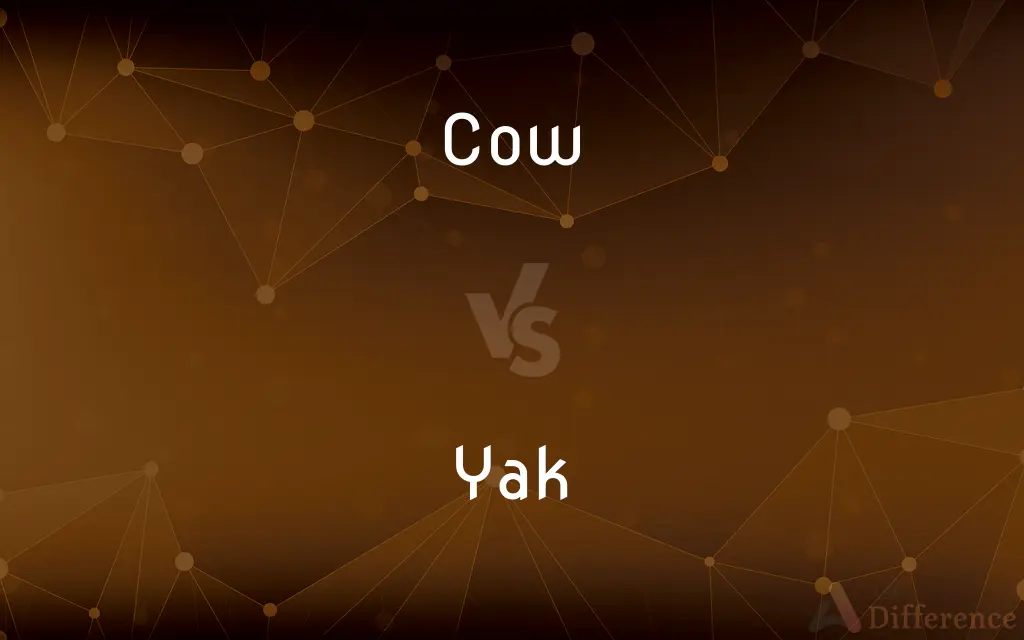Cow vs. Yak — What's the Difference?
Edited by Tayyaba Rehman — By Fiza Rafique — Updated on March 30, 2024
Cows are domesticated animals widely used for milk, meat, and labor, thriving in diverse climates, while yaks are adapted to cold mountain regions, providing milk, meat, and wool, and are used as pack animals.

Difference Between Cow and Yak
Table of Contents
ADVERTISEMENT
Key Differences
Cows, belonging to the species Bos taurus, are domesticated animals found globally and adapted to a wide range of environments. They play a significant role in agriculture for their milk, meat, and as draft animals. On the other hand, yaks, which are of the species Bos grunniens for domesticated types and Bos mutus for wild types, are native to the Himalayan region of South Central Asia, Tibetan Plateau, and as far north as Mongolia and Russia. They are particularly adapted to high-altitude environments, where they are used for their milk, meat, wool, and as pack animals.
While cows have been bred into numerous breeds with various characteristics suitable for different climates and purposes, yaks remain less varied genetically. Yaks are specifically adapted to cold climates, with their dense, long fur providing insulation, whereas cows have a more diverse range of adaptations to both hot and cold climates, depending on the breed. Yaks also produce a smaller quantity of milk compared to most dairy cows, but their milk is richer in fat and protein.
Cows are more commonly integrated into agricultural systems worldwide and are a primary source of milk and beef in many countries. In contrast, yaks are integral to the livelihood of pastoralists in the Himalayas and Central Asian highlands, where other domestic animals might not survive. Yaks are not only valued for their meat and milk but also for their ability to navigate difficult mountain terrains, making them indispensable as pack animals.
Yaks can live at altitudes above 6,000 meters, where their physiological adaptations, such as larger lungs and heart compared to lowland animals, allow them to efficiently use the thin oxygen at high elevations. Cows, although adaptable, do not possess these specific adaptations and generally live at lower elevations. This difference underlines the distinct ecological niches that cows and yaks occupy.
In cultural contexts, both animals hold significant value, but in different ways. Cows are revered in many cultures and religions, notably Hinduism, and are often associated with pastoral life and agriculture across the world. Yaks, meanwhile, are integral to the culture and economy of Tibetan and Mongolian societies, symbolizing the resilience and adaptability required to live in harsh mountainous environments.
ADVERTISEMENT
Comparison Chart
Species
Bos taurus
Bos grunniens (domesticated), Bos mutus (wild)
Habitat
Global, diverse climates
High-altitude regions of the Himalayas, Tibetan Plateau
Uses
Milk, meat, labor
Milk, meat, wool, pack animals
Adaptations
Varied, breed-dependent
Dense fur, larger lungs and heart for high altitudes
Milk Production
Higher quantity, varied fat content
Lower quantity, higher fat and protein content
Compare with Definitions
Cow
Cows are domesticated animals used for dairy, meat, and as draft animals.
The Holstein cow is renowned for its high milk production.
Yak
They have dense, long fur for insulation against cold.
Yak wool is used to make warm clothing and blankets.
Cow
Cows have been selectively bred for productivity and temperament.
Jersey cows are prized for their rich, creamy milk.
Yak
Their milk is rich in fat and protein, although produced in smaller quantities.
Yak milk is often turned into butter, cheese, and other dairy products.
Cow
Cows are a staple in global agriculture and diet.
Cow's milk is a common dietary staple worldwide.
Yak
Yaks are adapted to cold, high-altitude environments, providing meat, milk, and wool.
Yaks are vital to the economy of Tibetan plateau residents.
Cow
They hold religious significance in several cultures.
In Hinduism, cows are considered sacred and are protected.
Yak
Yaks are an integral part of Tibetan and Mongolian culture.
The yak is a symbol of endurance and strength in Tibetan culture.
Cow
They come in numerous breeds adapted to various environments.
The Brahman cow thrives in hot, humid climates.
Yak
Yaks are used as pack animals in mountainous terrains.
Yaks transport goods across the Himalayas where vehicles cannot reach.
Cow
Subdue, restrain, or overcome by affecting with a feeling of awe; frighten (as with threats)
Yak
The domestic yak (Bos grunniens) is a long-haired domesticated cattle found throughout the Himalayan region of the Indian subcontinent, the Tibetan Plateau, Northern Myanmar, Yunnan, Sichuan and as far north as Mongolia and Siberia. It is descended from the wild yak (Bos mutus).
Cow
The mature female of cattle of the genus Bos.
Yak
A large domesticated wild ox with shaggy hair, humped shoulders, and large horns, used in Tibet as a pack animal and for its milk, meat, and hide.
Cow
The mature female of certain other large animals, such as elephants, moose, or whales.
Yak
Trivial or unduly prolonged conversation.
Cow
To frighten or subdue with threats or a show of force.
Yak
Talk at length about trivial or boring subjects
She wondered what he was yakking about
Cow
(uncommon) Beef: the meat of cattle as food.
The only meat I eat is cow.
Yak
A wild, shaggy-haired ox (Bos grunniens) of the mountains of central Asia.
Cow
(uncommon) Any bovines or bovids generally, including yaks, buffalo, etc.
Yak
A domesticated yak, used as a work animal or raised for meat and milk.
Cow
(biology) A female member of other large species of mammal, including the bovines, moose, whales, seals, hippos, rhinos, manatees, and elephants.
Yak
Prolonged, sometimes senseless talk; chatter.
Cow
A woman considered unpleasant in some way, particularly one considered nasty, stupid, fat, lazy, or difficult.
Yak
To talk persistently and meaninglessly; chatter.
Cow
(mining) A chock: a wedge or brake used to stop a machine or car.
Yak
An ox-like mammal native to the Himalayas, Mongolia, Burma, and Tibet with dark, long, and silky hair, a horse-like tail, and a full, bushy mane.
Cow
To intimidate; to daunt the spirits or courage of.
Con artists are not cowed by the law.
Yak
(slang) A talk, particular an informal talk; chattering; gossip.
Cow
The mature female of bovine animals.
Yak
(slang) A laugh.
Cow
The female of certain large mammals, as whales, seals, etc.
Yak
(slang) Vomit.
Cow
A chimney cap; a cowl
Yak
(slang) A kayak.
Cow
A wedge, or brake, to check the motion of a machine or car; a chock.
Yak
To talk, particularly informally but persistently; to chatter or prattle.
Cow
To depress with fear; to daunt the spirits or courage of; to overawe.
To vanquish a people already cowed.
THe French king was cowed.
Yak
To vomit, usually as a result of excessive alcohol consumption.
Cow
Female of domestic cattle:
`moo-cow' is a child's term
Yak
A bovine mammal (Poëphagus grunnies) native of the high plains of Central Asia. Its neck, the outer side of its legs, and its flanks, are covered with long, flowing, fine hair. Its tail is long and bushy, often white, and is valued as an ornament and for other purposes in India and China. There are several domesticated varieties, some of which lack the mane and the long hair on the flanks. Called also chauri gua, grunting cow, grunting ox, sarlac, sarlik, and sarluc.
Cow
Mature female of mammals of which the male is called `bull'
Yak
Noisy talk
Cow
A large unpleasant woman
Yak
Large long-haired wild ox of Tibet often domesticated
Common Curiosities
Are yaks domesticated or wild animals?
There are both domesticated (Bos grunniens) and wild (Bos mutus) yaks, with the former being integral to certain high-altitude pastoral lifestyles.
Can yaks survive in low altitude environments?
Yaks can survive at lower altitudes but thrive in high-altitude conditions due to their physiological adaptations.
What are the main differences between cows and yaks?
Cows are more versatile in terms of climate adaptability and have been bred for a variety of uses worldwide, while yaks are specifically adapted to high-altitude, cold environments and provide meat, milk, wool, and labor.
How are yaks used by the people living in the Himalayas?
Yaks are used for their milk, meat, and wool, and as pack animals, playing a crucial role in the local economy and way of life.
What adaptations allow yaks to live at high altitudes?
Yaks have larger lungs and heart than lowland animals, dense fur for insulation, and a slow metabolic rate suited to the low oxygen levels of high altitudes.
Do yaks play a cultural role in the societies that raise them?
Yes, yaks are deeply integrated into the culture and economy of Tibetan and Mongolian societies, symbolizing strength and resilience.
Why do cows produce more milk than yaks?
Cows have been selectively bred for higher milk production, while yaks, adapted to harsh environments, naturally produce less milk but of higher fat content.
What is the significance of cows in Hinduism?
In Hinduism, cows are revered as sacred animals, symbolizing life and the Earth, and are protected and honored.
What are the benefits of yak milk compared to cow's milk?
Yak milk is richer in fat and protein, making it more nutritious, although it is produced in smaller quantities.
Can cows adapt to high-altitude environments like yaks?
While some cow breeds can adapt to various environments, they lack the specific physiological adaptations of yaks for high-altitude survival.
Share Your Discovery

Previous Comparison
Fiction vs. Fake
Next Comparison
Dichotomy vs. TrichotomyAuthor Spotlight
Written by
Fiza RafiqueFiza Rafique is a skilled content writer at AskDifference.com, where she meticulously refines and enhances written pieces. Drawing from her vast editorial expertise, Fiza ensures clarity, accuracy, and precision in every article. Passionate about language, she continually seeks to elevate the quality of content for readers worldwide.
Edited by
Tayyaba RehmanTayyaba Rehman is a distinguished writer, currently serving as a primary contributor to askdifference.com. As a researcher in semantics and etymology, Tayyaba's passion for the complexity of languages and their distinctions has found a perfect home on the platform. Tayyaba delves into the intricacies of language, distinguishing between commonly confused words and phrases, thereby providing clarity for readers worldwide.
















































